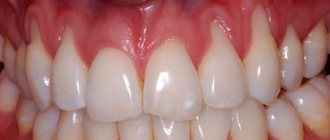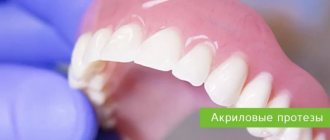The treatment of “fluxes” is carried out by a dental surgeon.
Do you feel afraid of the dentist?
Flux is the common name for any swelling in the cheek area and partly the neck - periodontitis, periostitis, complications of pulpitis and other inflammations. If you have inflammation of any origin or form, localized on the gums and in the oral cavity in general, you should definitely see a dentist.
Content:
- Why does it occur
- Signs
- How it proceeds
- Features of the development of periostitis in children and adults
- What happens if you don't undergo therapy?
- How to remove flux
- How to speed up recovery
- Preventive actions
An inflammatory dental disease that affects the periosteum tissue is called periostitis by dentists.
It is popularly known as flux. It is easy to recognize on your own - a painful abscess forms on the gum, which does not go away for a long time. It is unwise to fight this disease without medical help. When it appears, you should definitely make an appointment at a dental clinic and, during an in-person examination, find out from the doctor how to remove the flux without negative consequences for health.
It is simply impossible to ignore periostitis. It is usually accompanied by acute throbbing pain. Sometimes it can even lead to fever and a sharp decrease in performance. When there is a lot of pus in the “bag”, it bursts. Then the purulent masses flow out, and the symptoms cease to be so bright.
Other provocateurs
In addition to diseases and pathological changes that cause swelling of the cheek from the tooth, there are a number of other causes.
If an infection enters the patient’s body, medications that have an antibacterial effect should be taken. Thanks to this, you will get rid of the main cause, that is, infection, and the consequence - swelling. With inflammation of the lymph nodes in children, this situation often occurs.
The presence of a sebaceous gland cyst provokes changes in the facial part. In this case, surgical intervention will be required.
The cause is identified as neurological diseases. In addition to swelling of the cheek, the patient may suffer from congestion in the ear canal and discomfort in the throat area. To find out the reasons, you need to consult a neurologist.
A similar situation occurs with injuries or bruises. You can reduce the size of swelling by using a cold compress.
With a pathological change in the condition of the internal organs, swelling of the cheek is observed. To find out the reasons, you should consult your doctor.
It is important to know what to do if your cheek is swollen. Here are some tips to help reduce unpleasant symptoms:
- Often, after you have a wisdom tooth pulled out, you may experience swelling. To get rid of this, you should rinse your mouth with chamomile or sage. Chlorhexidine is perfect for these purposes.
- A fairly effective remedy is a saline (soda) solution. Rinsing with these products relieves pain and produces an antiseptic effect.
- While a wisdom tooth is coming out, it is worth using the help of special ointments and creams. Their use helps to minimize unpleasant symptoms.
- If your cheek is swollen after a wisdom tooth has been pulled out, you should use Kalanchoe or aloe juice. To do this, soak a cotton pad in the medicine, then apply it to the painful area.
- This manifestation is also possible with an insect bite. In this case, a decoction of chamomile, combined with aloe, helps.
Experts advise taking vitamin complexes daily to help improve the protective function of the immune system. It is better to reconsider your diet, in particular this concerns reducing the consumption of sweets. You can perform a light gum massage for preventive purposes.
By following basic rules of personal hygiene and regularly visiting the dentist, you will prevent complications and the development of pathological conditions.
Dental disease and its treatment is an unpleasant phenomenon that many adult men and women try to avoid or delay until an emergency. But the most dangerous thing about far-fetched fear is that while a person waits for the disease to become unbearable, destruction of teeth and gums occurs, which in the initial stages could be treated with fairly simple, almost painless and inexpensive methods. In this article we will talk about gumboil, how to get rid of it, and how to help the patient at home.
Why does it occur
In order to understand how to remove flux, it is necessary to establish what led to its appearance. If the provoking factor is not eliminated, the disease may return. Among the main reasons for the violation:
- untreated deep caries;
- a large amount of hard plaque extending far under the gum;
- dental root cyst;
- inflammatory lesion of the gingival pocket;
- receiving mechanical injuries;
- general hypothermia of the body (especially against the background of reduced immunity);
- poor oral hygiene.
According to statistics, most often the disease occurs precisely because of advanced caries and pulpitis. If there is a large “hole,” the infection easily penetrates deep into the dental tissues, affects the surrounding structures and causes nerve destruction. Then pulpitis develops.
If left untreated, it will become chronic. The pain will become mild, but this does not mean that the disease has gone away. It’s just that now it’s happening secretly. The infection will continue to destroy the internal structures of the diseased unit. As they die, narcotic masses will begin to be released. To remove them, an abscess forms on the gum. This is flux.
If it is localized on the periosteum of the upper jaw, then the upper lip and the area under the eye swell. If inflammation progresses in the lower jaw, the chin and cheek swell, and the lymph nodes become painful.
Relief from herbal infusions
- You can brew an infusion of calamus, calendula, and string. Sage, oak root, common nettle, and chamomile help relieve swelling. Herbs are often mixed. For 0.5 liters of liquid, a mixture of herbs in the amount of 1 tbsp is sufficient. l. After steeping well, rinse your mouth with the resulting tincture several times a day.
- Decoctions of plantain and knotweed are also prepared to relieve abscesses. The finished drug is drunk 100 g twice a day. To prepare the decoction, 1 tbsp is enough. l. raw materials into 2 cups of boiling water.
- For compresses you will need various products. The onion is boiled or baked in milk. After grinding it into a paste, place it in gauze. Place a compress on the painful gum. By doing the procedure at least 4 times, you can relieve pain and reduce swelling. Onions are a natural antiseptic.
Signs
You can understand that periostitis has developed by the following symptoms:
- tooth pain;
- swelling of the gums;
- an abscess at the base of the diseased unit;
- increased pain when pressing on the affected area;
- swelling of the cheek;
- increased body temperature;
- swelling of the lymph nodes.
If these symptoms occur, you should make an appointment with the dentist as soon as possible. In the early stages, the problem can be eliminated quite easily and quickly. Delay is fraught with health-threatening complications.
Using cold to relieve swelling
You can alleviate the condition at home by lowering the temperature and reducing swelling. For this purpose, make a compress. It is able to remove the sensation of pain and relieve swelling during flux. Cold is applied to the cheek, which is swollen. Ice or any cold material is kept near the cheek for several minutes. It will not be possible to relieve inflammation immediately. The procedure will have to be repeated several times. It will help remove pus and kill bacteria that contributed to the appearance of gumboil. Thanks to the cold applied to the cheek, recovery will begin much faster.
A solution containing salt and soda helps a lot. The ingredients are taken in a small spoon and diluted in 250 ml of water. Rinse once for an hour. Then the procedure is repeated.
How it proceeds
The disease progresses through several successive stages:
- Acute serous. Spreads quickly. In just two or three days, a large, painful “bump” forms, with pus inside. The cheek tissues swell.
- Acute purulent. The pain becomes more pronounced, the person feels an unpleasant pulsation. The mucous membrane in the area of the affected unit turns red and swells. Body temperature rises.
- Acute diffuse. The swelling becomes voluminous. It can go under the eye or onto the nose. The patient's appearance changes significantly for the worse.
- Chronic. The painful process fades away and is replaced by a chronic one. The patient may mistakenly think that the problem has disappeared without a trace. In fact, it only calmed down for a while. Periodically, the disease will recur.
The sooner a sick person consults a doctor, the higher his chances of a speedy recovery.
Features of the development of periostitis in children and adults
In adults, the disease usually has vivid symptoms. Most often it is caused by bad habits and ignoring the rules of oral hygiene. The tissues surrounding the root become inflamed. Persistent pain forces a person to seek dental care.
In children, flux usually progresses with mild symptoms. This is due to the fact that in children the immune system reacts less actively to abnormal processes in the oral cavity. Even if the purulent “bump” does not hurt the child, a consultation with a dentist is still required.
Decoctions of herbs and herbs
Decoctions eliminate pain and swelling, relieve inflammation, soothe teeth, and have antimicrobial and deodorizing properties. Mouth rinses provide excellent anti-inflammatory results and help speed up the treatment of dental flux.
Herbs such as sage, lemon balm and herbal preparations based on them have an excellent healing effect.
Herbs have a positive effect on pathogens and strengthen the immune system. To combat gumboil, the following recipes are most often used:
- To 2 tbsp. add 0.5 liters of boiling water to spoons of dried sage. Infuse the broth in a water bath for 50 minutes, cool to room temperature. Rinse your mouth 2-3 times for an hour.
- 2 tbsp. mix spoons of sage and oak bark thoroughly with 3 tbsp. spoons of St. John's wort. Brew the resulting mixture with 1 liter of boiling water. Cover the container with a lid and leave to steep for 30 minutes. Filter the uzvar and rinse your mouth 6-7 times a day. All processes of rinsing the mouth are carried out exclusively with a hot solution.
- In a small container, mix in equal proportions (for example, 1 tablespoon each) sage, eryngium and gorichnik. Brew with 1.5 glasses of very hot water or vodka. Close the container tightly and leave to infuse in a dark place for 2 hours. Rinse several times a day. It is also recommended to soak cotton wool in the infusion and apply it to the sore tooth.
- Add 1 liter of boiling water to 0.5 cup of lemon balm. Cover tightly with a lid and a warm towel for 1 hour. Carry out the mouth rinse procedure every 2 hours.
- Mix equal amounts of lemon balm, oak bark and sage. Cover with boiling water. After the solution has cooled, rinse your mouth up to 10 times throughout the day.
- Mix 100 g of mint, 50 g of angelica, birch buds and periwinkle. Pour 1 liter of hot water into the container. Leave for 50 minutes and rinse up to 8 times a day.
- 2 tbsp. Infuse tablespoons of hyssop herb in one cup of boiling water for 2 hours. Strain thoroughly and cool. Add 10 drops of vinegar and rinse the entire mouth.
- Mix green tea and sage in a container. Add a glass of boiling water and leave. Filter the infusion and add 0.5 teaspoons of salt. Stir everything. During the day, rinse your mouth with a hot solution as often as possible.
- Brew 2 tbsp. spoons of oak bark 0.5 liters of boiling water and set aside to infuse for 30 minutes. By rinsing every 1.5-2 hours, you can relieve pain.
What happens if you don't undergo therapy?
It is unacceptable to treat purulent gum lesions as a minor dental disorder. It is very insidious and rarely disappears without a trace on its own. Often, if treatment is refused, the following occurs:
- Abscess. It is a consequence of a long-term presence of a pus-filled sac in the area of the tooth root. The abscess grows and then ruptures.
- Phlegmon. Represents an extended lesion. It usually occurs after a rupture of a purulent sac, if the patient does not comply with the dentist’s instructions, does not rinse the mouth with a special antiseptic solution, or apply anti-inflammatory gels.
- Osteomyelitis of the jaw. It occurs if the gums are not treated for a very long time. The pathological process spreads to the jaw bone, which is very dangerous.
- Inflammation of individual sinuses of the skull. It is also diagnosed with advanced periostitis. The maxillary, frontal and sphenoid sinuses are affected.
It is extremely rare that the disease affects brain tissue. Then the person may even die.
Causes
The main culprit in the formation of a purulent focus is deep caries. Destroyed tooth tissues do not retain bacteria. Penetrating into the dental canals, pathogenic microbes cause inflammation of the soft tissue, destroy the bone structure and enter the periosteum, where purulent inflammation begins to develop.
Other factors can lead to the disease:
- tooth injury;
- chronic infection of ENT organs;
- tartar;
- stomatitis;
- purulent neoplasm at the apex of the tooth root;
- poor-quality dental canal treatment.
How to remove flux
To avoid purulent damage to the pulp zone and periosteum, you need to receive qualified dental care in a timely manner. In the early stages of the disease, in order to prevent further progression of the inflammatory process, the patient is prescribed anti-inflammatory drugs and antibiotics. It is mandatory to open the abscess. The wound is then cleaned and washed with an antiseptic.
In some cases, to prevent re-accumulation of pus, drainage is installed for several days. All surgical procedures are always performed under general anesthesia so that the patient does not experience pain.
To support the patient’s body, he is additionally prescribed a vitamin and mineral complex. If necessary, physiotherapy is included in the treatment course. Good results can be obtained using UHF and electrophoresis.
It is important to strictly follow all medical recommendations and under no circumstances interrupt antibiotic therapy. Treatment is considered successfully completed if pus is no longer released, pain does not occur, and the entire wound has healed. In some cases, after healing, a small bluish scar remains on the gum. You shouldn't worry about it. This means that the defeat was very deep. Over time, the gums will return to their normal appearance.
Ointments and lotions according to folk recipes
Ointments made from natural ingredients help well with flux and have virtually no contraindications, except for individual intolerance to the components.
One glass of odorless sunflower oil must be steamed in any enamel container. Gradually add: a little proprolis and wait until it melts, half a boiled and finely chopped yolk.
the yolk slowly and gradually. Leave for seven minutes for 5-10 to continue to warm up, but stir occasionally. Then remove from heat, cool and strain using nylon cloth. Lubricate sore spots in the mouth with warm ointment twice a day. Store the product in the refrigerator.
In order for the abscess with pus to break through as quickly as possible, you can use honey ointment. Pour a tablespoon of linden Heat an ordinary nail over a fire and dip it in honey.
That part of the honey that has darkened after the action of the nail should be collected with a cotton swab or cotton swab and applied to the area affected by the flux overnight. After 3 hours, the pus should break through.
Apply to the sore gum an unlimited number of times a day.
There is also a folk recipe that, despite its strangeness, really works. a clove of garlic in half and place the inside of it on your wrist, where the vein is pulsating. Rub and secure with a gauze bandage.
This method relieves toothache for several hours. You can also apply garlic to the sore gum and tooth to kill germs and slightly reduce pain.
medickon.com
How to speed up recovery
To make healing go faster, it is important not only to follow the dentist’s instructions, but also to remember the rules:
- do not heat the area where the pus was located;
- do not take antibiotics or any other medications unless prescribed by a doctor;
- do not use any folk recipes without consulting your doctor;
- Until the wound is completely healed, do not use aspirin or any medications that contain acetylsalicylic acid.
If the “bump” appears again, it is recommended to immediately contact a dental clinic.
Treatment with medications
Conventional painkillers like analgin do not always help with the unpleasant symptoms of the disease, so you should use drugs aimed at eliminating severe toothache and reducing swelling. Such means include:
- Diclofenac. It relieves inflammation well and helps relieve toothache. Take 25-50 mg once or twice a day.
- Nimesil. Special anti-flux tablets that effectively reduce inflammation in all forms and stages of the disease. You should take 200 mg per day, divided into two doses of 100 mg.
- Diazolin. Included in the group of anti-allergenic drugs for the treatment of flux. Has an anti-edematous effect and prevents the spread of pus. You need to take 1-3 tablets per day, depending on the degree of swelling.
Local treatment of gumboil with pharmaceutical agents involves the use of ointments that can quickly heal damaged gum tissue and eliminate the inflammation process.
Vishnevsky ointment
It is able to stop the formation of pus, suspend the activity of bacteria and reduce pain, thanks to the presence of castor oil and birch tar in the composition.
This ointment is used in the initial stages of flux, or after the abscess breaks through. Apply the ointment to a piece of sterile bandage and keep it on the affected area for several hours.
Levomekol
It is able to defeat many types of bacteria and restores tissue well.
The ointment can be used in the presence of oozing pus ; it still penetrates effectively into the gums, and therefore the drug is recommended for purulent processes in the oral cavity with flux. Apply levomekol three times a day and keep it on the damaged gum for 2-3 hours.
Metrogyl denta
A gel that is directly rubbed into the gums. It has a quick effect and prevents complications. Use the gel three times a day, after which you should not eat or drink for half an hour.
Preventive actions
To reduce the likelihood of periostitis, you need to take care of your teeth and visit the dentist at least once a year. You can't start caries. As soon as a dark spot appears on the surface of the dental crown, it needs to be treated.
After eating, it is advisable to rinse your mouth with warm water. To make hygiene as high as possible, it makes sense to use not only a brush and toothpaste, but also dental floss and irrigators. It is very important to remove tartar every year at the dentist's office.
An important place in the issue of prevention is given to diet. You should eat as much fresh fruits, vegetables, and plant foods as possible. They require more thorough chewing and thus have a positive effect on the ligamentous apparatus that holds the tooth. They also provide natural cleansing of crowns from soft plaque.
If you have any questions about how to remove flux, please contact the doctors at the Line of Smile dental clinic for help. We specialize in the treatment of this disease and know how to quickly rid our patients of it.
Rinse
To rinse the gums during gumboil, decoctions of anti-inflammatory herbs, saline and alkaline solutions, and antiseptic pharmaceutical preparations are used.
The basis for any rinse is a solution of salt and baking soda (1 teaspoon per 2 glasses of water). Rinsing should be done once every half hour. This will eliminate swelling and inflammation and reduce toothache.
Rinsing can be done with ready-made preparations sold in pharmacies: Miramistin, Chlorgeskidine, Iodinol, Hexoral, Furacilin. All of them have antiseptic and anti-inflammatory effects and are available without a prescription. The procedure must be repeated several times a day, keeping the solution in the mouth for about a minute. It is not recommended to use these drugs to treat flux in children, as there is a risk of ingestion.
Of the herbal remedies, sage decoction is considered the most effective. It can be mixed in half with a decoction of chamomile, calendula, mustard grass, oak bark or St. John's wort. Gargling with decoctions should be done as often as possible, up to 10 times a day. You can also mix sage herb with regular green tea, add ¼ teaspoon of table salt and pour a liter of boiling water over this mixture. Important: rinse with warm liquid, but not hot or cold.










